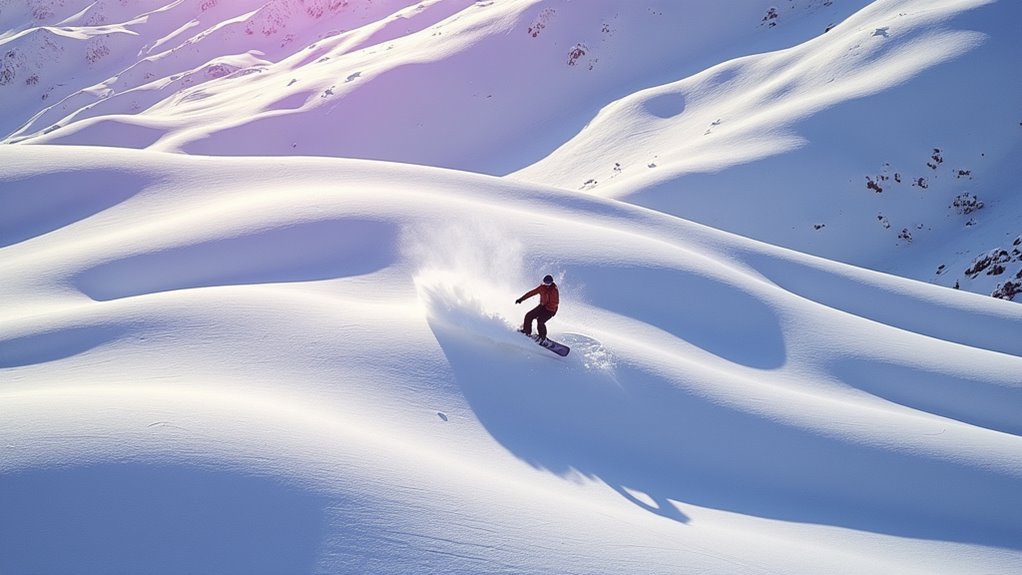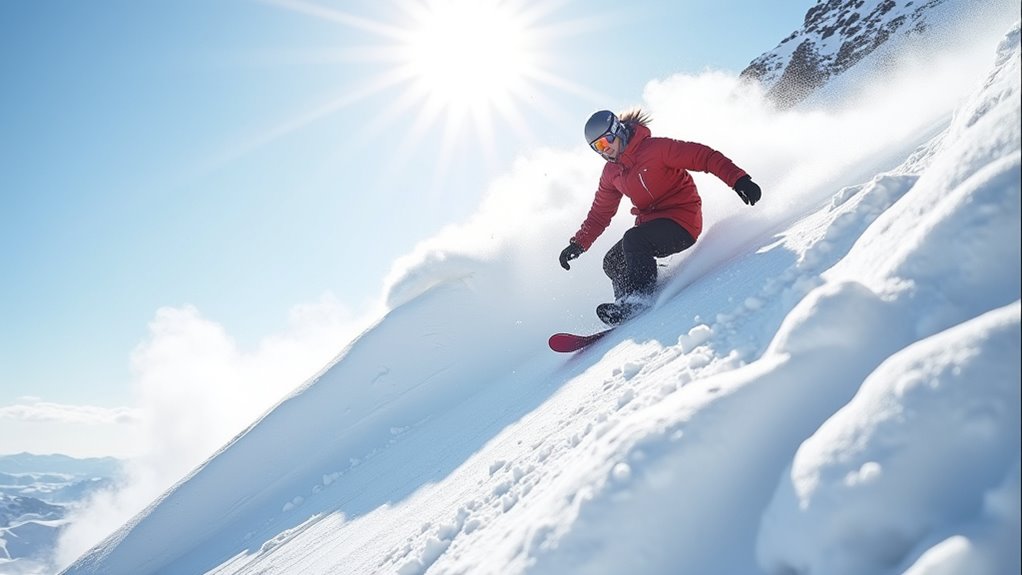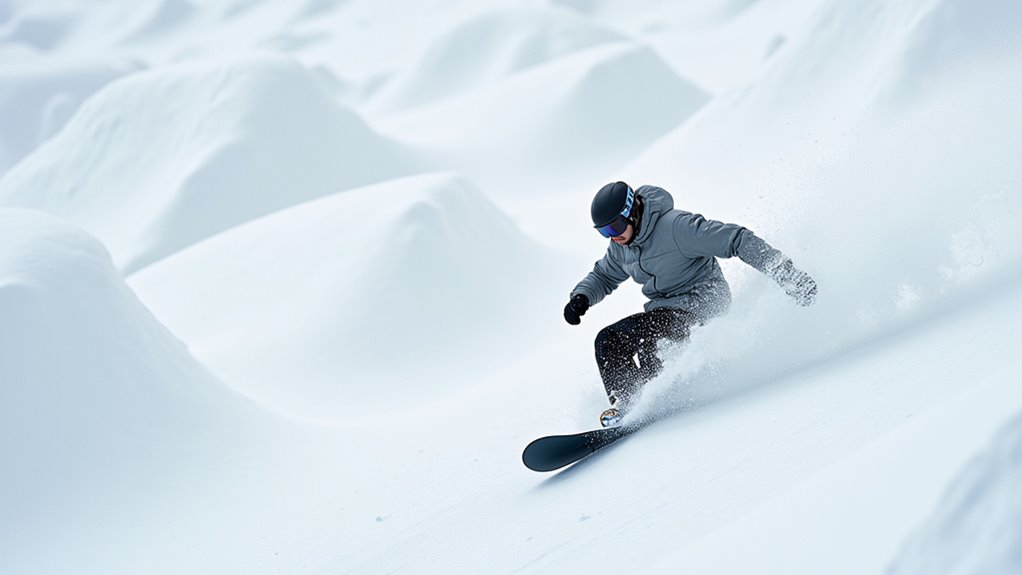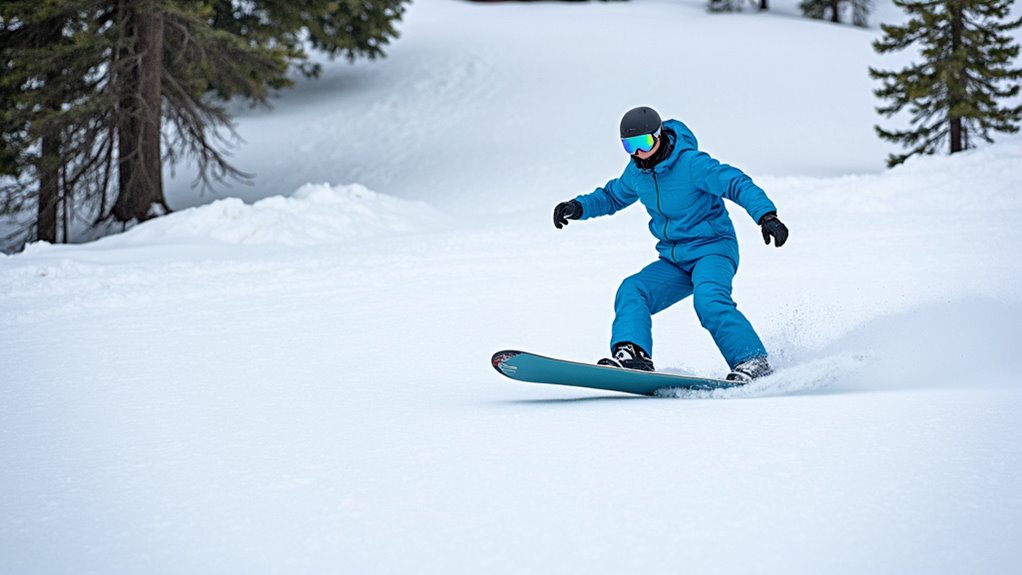Physical Address
304 North Cardinal St.
Dorchester Center, MA 02124
Physical Address
304 North Cardinal St.
Dorchester Center, MA 02124

Master mogul snowboarding with proven techniques that transform intimidating bumps into flowing terrain—discover the rhythm secrets pros use.
You’ve probably stared down a mogul field and felt that familiar knot in your stomach. Those intimidating bumps don’t have to be your nemesis—they can become your playground with the right approach. The key isn’t about charging through them with brute force or avoiding them altogether. Instead, it’s about understanding how your body moves with the terrain and developing a rhythm that flows naturally with each bump. Let’s break down what separates confident mogul riders from those who struggle.

Before you can tackle moguls effectively, you need to understand how these challenging bumps form on the mountain. Moguls develop naturally when skiers and snowboarders repeatedly turn in the same spots, carving out troughs and leaving mounds of snow between them.
You’ll typically find moguls on steep intermediate and advanced runs where traffic is heavy.
Each mogul has three distinct parts you should recognize: the face (front slope), the trough (valley between bumps), and the back (downhill side). The steepest part is usually the face, while the back offers a brief respite.
Mogul fields vary in size and spacing – some are tight and small, others spread out with larger formations.
Understanding these terrain features helps you plan your line and anticipate challenges ahead. Whether you’re considering renting equipment for your first mogul experience or investing in your own gear, proper preparation is essential for navigating these demanding slopes safely.
When you’re maneuvering moguls, your body position becomes your greatest asset for maintaining control and balance. Keep your knees bent and flexible, acting as natural shock absorbers when you hit bumps. Your stance should be slightly wider than normal to increase stability over uneven terrain.
Center your weight over your board’s middle, avoiding leaning too far forward or backward. Keep your arms slightly extended for balance, but don’t flail them wildly. Your torso should remain relatively quiet while your legs do most of the work.
As you approach each mogul, compress your body by bending your knees more deeply. When cresting the bump, extend your legs to maintain contact with the snow. This compression-extension movement helps you absorb terrain changes smoothly. Proper preparation through injury prevention techniques will help ensure your body can handle the physical demands of mogul snowboarding throughout the day.

Your body positioning works hand-in-hand with smart speed management to keep you in control through mogul fields. The key is using your edges strategically rather than relying on brute force turns. Make shorter, more frequent turns by engaging your heel-side and toe-side edges as you navigate around each bump. This creates natural speed checks without jarring stops.
Don’t fight the terrain—work with it. Use the backside of moguls as natural braking zones by pressing into your edges as you ride up each bump’s face. Keep your turns linked and flowing rather than making sudden direction changes that’ll throw you off balance. Just like in whitewater rafting, maintaining proper body positioning is crucial for navigating challenging terrain safely and effectively.
While speed control keeps you stable, understanding the fall line gives you the roadmap through mogul chaos. The fall line is gravity’s natural path down the slope—where water would flow if poured on the mountain.
In moguls, you’ll spot multiple mini fall lines between bumps, creating natural corridors for your descent. Don’t fight these natural paths. Instead, read them like a map and choose your route before committing.
Look three to four moguls ahead, identifying the smoothest progression between bumps. Avoid the temptation to go straight down the steepest fall line—that’s where moguls are biggest and most challenging.
Pick gentler angles that snake between bumps, giving you more time to control speed and make clean turns. Just like selecting budget-friendly gear for any outdoor adventure, choosing the right path through moguls requires balancing cost and benefit—in this case, trading directness for control and safety.

As you approach each mogul, your legs become shock absorbers that compress and extend to maintain balance and control. Flex your knees and ankles as you ride up the bump’s face, absorbing the terrain’s impact. This compression keeps your upper body stable while your board follows the contours.
At the mogul’s peak, quickly extend your legs to maintain contact with the snow as you transition into the trough. Think of it like riding a wave – you’re constantly adjusting your stance height to match the terrain’s rhythm.
Practice this flexion-extension pattern on smaller bumps first. Keep your core engaged and arms forward for balance. The key is smooth, continuous movement rather than rigid positioning. Your legs should flow like springs, constantly adapting to each bump’s unique shape and size.
Just as expecting moms need to adapt their physical activities for safety and comfort, snowboarders must constantly adjust their technique to match the demanding terrain of mogul fields.
When moguls create unpredictable terrain beneath your board, successful edge control becomes more challenging than on groomed runs. You’ll need to adjust your timing and pressure application constantly as the snow conditions change beneath you.
Focus on progressive edge engagement rather than aggressive carving. Apply gradual pressure to your edges while maintaining a centered stance over your board. This prevents catching an edge on unexpected bumps or ice patches.
Initiate turns earlier than you’d on groomed terrain. Start your turn preparation at the top of each mogul, allowing gravity and terrain changes to assist your rotation. Keep your knees bent and ready to absorb impact.
Practice quick edge transitions by rolling from heel-side to toe-side smoothly. Avoid over-edging, which can cause you to catch and tumble in the irregular terrain.
Just as anglers must read water conditions at top fishing destinations to find success, snowboarders need to constantly read the changing terrain features in mogul fields to maintain control and flow.

Since moguls create a natural rhythm across the slope, you’ll want to sync your movements with the terrain’s flow rather than fighting against it.
Work with the mountain’s natural rhythm instead of battling against the bumpy terrain beneath your skis.
Focus on reading the mogul line ahead and anticipating each bump’s timing. Start your turns at the crest of each mogul, allowing gravity to help initiate your edge change as you descend into the trough.
Count out a steady rhythm—”turn, absorb, extend”—to maintain consistent timing. Your knees should compress as you ride over bumps and extend as you enter valleys.
Don’t rush between moguls; instead, let each turn develop naturally.
Practice on smaller, evenly-spaced moguls first to establish your timing before tackling larger, irregular bump fields where rhythm becomes even more critical. Just like scuba divers who master their breathing rhythm underwater, snowboarders must develop this natural cadence to flow smoothly through challenging terrain.
While proper technique forms the foundation of mogul riding, your equipment setup can make or break your performance on bumps. You’ll want a shorter, stiffer board that responds quickly to direction changes. A board that’s 8-12 centimeters shorter than your all-mountain setup works best for tight mogul turns.
Set your bindings slightly back from center to help with quick pivots and absorption. Stiffer boots provide better response and control when maneuvering bumps rapidly. Your stance should be narrower than usual – about shoulder-width apart – giving you better balance and quicker edge transitions.
Don’t forget properly tuned edges. Sharp edges grip better on icy mogul faces, while a fresh wax job keeps you moving smoothly through variable snow conditions you’ll encounter in bump fields. Just as some locations present dangerous diving spots that require specialized equipment and preparation, challenging mogul runs demand the right gear setup to navigate safely.

After you’ve dialed in your equipment, it’s time to tackle your first mogul runs with a strategic approach. Start on smaller, well-formed bumps rather than diving into steep, gnarly terrain. Choose runs during off-peak hours when they’re less crowded and intimidating.
Focus on linking just two or three turns initially. Don’t worry about perfection – simply practice absorbing bumps with your legs while maintaining balance. Pick a clear line down the fall line and commit to it.
Build your skills progressively by spending multiple sessions on the same beginner mogul run. This repetition builds muscle memory and confidence simultaneously.
Watch other snowboarders navigate the terrain, noting their line choices and timing.
Consider investing in affordable camping gear for overnight trips to mountain resorts, allowing you to maximize your practice time on the slopes.
Once you’ve mastered basic mogul navigation, you’re ready to push your riding to the next level with aggressive techniques that’ll transform how you attack the bumps.
Start carving tighter S-turns down the fall line, using each mogul’s face as your turning point. Keep your knees bent and weight centered while maintaining forward momentum. Don’t ride defensively—commit to each turn with confidence.
Commit to aggressive S-turns down the fall line—use mogul faces as turning points while maintaining centered weight and forward momentum.
Practice absorbing moguls by flexing your legs as you ride over them, then extending as you enter the trough. This technique maintains speed while keeping you in control.
Work on linking turns more aggressively by initiating your next turn before completing the previous one. Your board should flow seamlessly from edge to edge, creating a dynamic rhythm that matches the mogul field’s natural spacing.
Just like mountain climbers need essential gear for safety and performance, aggressive mogul riders should invest in proper protective equipment to handle the increased risks of high-speed bump navigation.
Think of mogul riding like dancing through a crowded room at a party. You’re weaving between people, reading the space ahead, and adjusting your rhythm to avoid collisions. Studies show that 80% of mogul crashes happen when riders fixate on the bump directly in front of them instead of scanning ahead. Keep your eyes up, trust your instincts, and let your body flow with the terrain’s natural rhythm. You’ve got this.